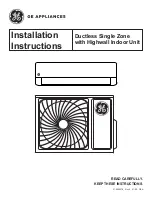
TROUBLE SHOOTING GUIDE
NOTE
The compressor and outdoor fan
do not operate
The outdoor fans run but the
compressor will not start
Low refrigerant charge
insufficient airflow
The compressor runs continuously
The compressor starts but shuts
down quickly on thermal protection
Power failure
Fuse blown or circuit breaker open
Voltage is too low
Faulty contactor, thermostat or relay
Electrical connections loose
Faulty capacitor (single phase models)
Thermostat adjustment too low (in heating
mode) or too high (in cooling mode)
Incorrect wiring, terminals loose
Pressure switch tripped (depending on mode)
Motor windings cut or grounded
Faulty capacitor (single phase models)
Make sure there are no leaks
Check the air filter, the damper positions
Check that air is not being recycled
Check cleanliness of unit coils
Capillaries obstructed or orifice plugged
(humidity)
Liquid and gas lines insulated together
Thermostat adjustment too high (in heating
mode) or too low (in cooling mode)
No fan operation or faulty fan
Reffrigerant charge too low, leakage
Heating/cooling load underestimated
Air or incondensables in refrigerant circuit
Too much or too little refrigerant
Air or incondensibles in refrigerant circuit
Faulty compressor
Power supply voltage too high or too low
Faulty condenser (single phase models)
Faulty thermostat
Restriction in the refrigeration circuit
Frostec or plugged expansion device
Poor airflow on indoor or outdoor unit
Faulty power supply
Changeover valve damaged or blocked open
(heat pump units)
Unit short-cycles
The Compressor runs too long or continuously
Insufficient heating or cooling
No heating or cooling
Cause
Symptoms
Contact the electrical utility company
Replace the fuse or reset the breaker
Find the cause and fix it
Replace the faulty component
Retighten the connections if necessary
Find the cause, then replace capacitor
Check thermostat setting
Check and retighten
Find the cause, then reset
Check the wiring and the compressor winding
resistance
Find the cause, then replace capacitor
Remove charge, repair, evacuate and recharge
Clean or replace, set the air damper to the right
position
Clean the coils
Remove charge, repair, evacuate and
recharge
Insulate them separately
Change the setting
Check condenser air circulation
Find leak, repair and recharge
Reduce load or use next unit size up
Remove charge, evacuate and recharge
Remove charge, evacuate and recharge
Remove charge, evacuate and recharge
Determine the cause and replace compressor
Solve the problem
Determine the cause and replace
Replace
Find restriction and repair
Remove charge, evacuate and recharge
Clean the coil and the filter if necessary, check
that motors are operating properly
Check wire gauges, etc
Replace it
Remedy
Cause
Symptoms
Remedy
Ice build-up indoor coil
Faulty installation
Compressor noisy
Thermostat
Safety device
Excessive discharge pressure
Insufficient discharge pressure
Excessive suction pressure
Insufficient suction pressure
Low refrigerant charge, refrigerant leak
Insufficient airflow
Low operating temperature limit exceeded
Frosted Indoor coil
Make sure vibration isolators have been
installed.
Check piping collars
Make sure that the compressor is not losing
oil
Excessive oil or refrigerant charge
Thermostat incorrectly adjusted
Check continuity through fuse
Safety thermostat opens
Faulty unit wiring
Out door coil dirty
Indoor unit fan (heating mode) or outdoor
unit fan (cooling mode) faulty
Excessive refrigerant charge
Air or incondensables in refrigerant circuit
Refrigerant charge too low
Liquid line blocked or crushed
Compressor valves worn out or leaking
Refrigerant overcharge
Cycle changeover valve faulty or leaking
(heat pump units)
Low refrigerant charge
Outdoor unit coil (heating mode) or indoor
unit coil (cooling mode frosted)
Insufficient airflow on the outdoor unit coil
(heating mode) or the indoor unit coil
(cooling mode)
Suction line obstructed
Expansion device obstructed or iced up
Poor contact the line and the defrost sensor
in the heating mode (heat pump units)
Condenser airflow too high (in the cooling
mode) in relation to outdoor air temperature
Repair the leak and recharge
Check the condition of the air filters
Check the cleanliness of the indoor coil
Check fan motor operation
Check that the air damper opens correctly
(on unit equipped with a damper)
Install a low temperature kit
Tighten any loose components
Repair and add oil
Repair or replace the thermostat
Readjust the thermostat
Remove excess charge
Replace faulty elements
Check indoor unit airflow
Check cleanliness of air filter and coil
Open air balancing dampers
If ducts are long, inhibit low, and perhaps even
medium fan speeds
Check that wiring complies with applicable
diagrams
Clean the coil
Replace the fan
Remove excess charge
Check the circuit, evacuate, and recharge
Find and repair the leak, top up refrigerant
charge
Find obstructions and eliminate them
Replace the compressor
Remove excess refrigerant
Replace the valve
Add some refrigerant
Find cause and fix it
Make sure that the indoor or outdoor unit fan
is operation properly
Find obstruction and eliminate
Remove charge, evacuate, recharge
Reinstall the sensor correctly using a contact
compound. Insulate the assembly
Install a low temperature kit
Unit noisy
Electric heat does not work
(on indoor units fitted with this option)
Excessive or insufficient suction pressure
Excessive or insufficient discharge pressure
Open the main unit power switch before proceeding with any repair operations.






























